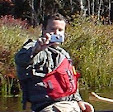 |
| The crew get ready |
I took my first swiftwater rescue class with the Blackstone Valley Paddled Club back around 2007. That class was also at Zoar Outdoor and focused on basic rescue skills such as safe and aggressive swimming, throw rope rescues and wading rescues. Shortly after that, I took a more advanced swiftwater course with the NHAMC that also covered strainers, rescue vests and rope-based rescues. Since it has been a while since I’ve had a refresher course, I was glad to get into this one.
 |
| Hand of God Rescue |
After the classroom session we headed out to the river to review boat-based rescues including the “T” Rescue, Parallel/Side-by-Side Rescue, and the Hand of God Rescue. We also practiced emptying swamped boats and deep water recoveries. As a canoeist, its good to know that a Side-by-Side Rescue will work with a kayaker expecting a "T" Rescue. Also good to know the best way to empty a swamped kayak. Those are skills I can use on the river.
 |
| Waiting for the next swim on Turtle Rock |
Before packing up, we took a moment to remember Jocelyn Barrett, a frequent Deerfield paddler and active member of the community who passed away last week. It was a long, cold day, but definitely worth the time. Glad I was able to participate.
Swimming below Zoar Gap from Erik Eckilson on Vimeo.
Links:















